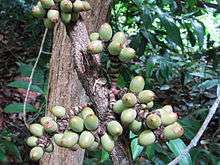Gnetum
Gnetum is a genus of gymnosperms, the sole genus in the family Gnetaceae and order Gnetales. They are tropical evergreen trees, shrubs and lianas. Unlike other gymnosperms, they possess vessel elements in the xylem. Some species have been proposed to have been the first plants to be insect-pollinated as their fossils occur in association with extinct pollinating scorpionflies.[2] Molecular phylogenies based on nuclear and plastid sequences from most of the species indicate hybridization among some of the Southeast Asian species. Fossil-calibrated molecular-clocks suggest that the Gnetum lineages now found in Africa, South America and Southeast Asia are the result of ancient long-distance dispersal across seawater.[3][4]
| Gnetum | |
|---|---|
 | |
| Gnetum macrostachyum in Thailand | |
| Scientific classification | |
| Kingdom: | Plantae |
| Clade: | Tracheophytes |
| Division: | Gnetophyta |
| Class: | Gnetopsida |
| Order: | Gnetales T.M.Fries |
| Family: | Gnetaceae Lindleyx |
| Genus: | Gnetum L. |
| Distribution | |
| Synonyms[1] | |
| |
Their leaves are rich in bioactive compounds, like flavonoids and stilbenes, which have "remarkable medical effects". Of the species studies so far, Gnetum have photosynthetic and transpiration capacities which are considerably lower than those of other seed plants, due to the absence of multiple chloroplast genes essential for photosynthesis, a trait they seem to share with Ephedra and Welwitschia.[5]
Species
- Gnetum sect. Gnetum
- Gnetum subsect. Gnetum - 2 species of trees; Southeast Asia, Pacific Islands
- Gnetum gnemon - Tibet, Yunnan, Assam, Indochina, Nicobar Islands, Malaysia, Indonesia, Philippines, New Guinea, Melanesia, Micronesia
- Gnetum costatum - New Guinea, Solomon Islands
- Gnetum subsect. Micrognemones - 2 species of lianas; tropical west Africa
- Gnetum africanum - central Africa from Cameroon to Angola
- Gnetum buchholzianum - central Africa from Nigeria to Zaire
- Gnetum subsect. Araeognemones - 9 species of lianas; tropical South America and Central America - Ituá
- Gnetum camporum - Venezuela
- Gnetum leyboldii - Costa Rica, Panama, Venezuela, Colombia, Ecuador, Peru, Amazonian Brazil
- Gnetum nodiflorum - Guianas, Venezuela, Colombia, Ecuador, Peru, northwestern Brazil
- Gnetum paniculatum - Guianas, Venezuela, northwestern Brazil
- Gnetum schwackeanum - Amazonas State of southern Venezuela, northwestern Brazil
- Gnetum urens - Guianas, Venezuela, Peru, northwestern Brazil
- Gnetum venosum - Bolívar State of southern Venezuela, northwestern Brazil
- Gnetum subsect. Gnetum - 2 species of trees; Southeast Asia, Pacific Islands
- Gnetum sect. Scandentia - about 20 species of lianas; southern Asia
- Gnetum subsect. Stipitati
- Gnetum arboreum - Luzon in Philippines
- Gnetum contractum - southern India
- Gnetum edule - southern India
- Gnetum gracilipes - Yunnan + Guangxi in China
- Gnetum latifolium - Assam, much of Southeast Asia, New Guinea, Bismarck Archipelago
- Gnetum montanum - Himalayas, southern China, northern Indochina
- Gnetum oblongum - Bangladesh, Myanmar
- Gnetum pendulum - Tibet, southern China
- Gnetum tenuifolium - Peninsular Malaysia, Thailand, Sumatra
- Gnetum subsect. Sessiles
- Gnetum acutum - Sarawak
- Gnetum bosavicum - Papua New Guinea
- Gnetum catasphaericum - southern China
- Gnetum cleistostachyum - southern China
- Gnetum cuspidatum - Indochina, Indonesia, Malaysia, Philippines
- Gnetum diminutum - Borneo
- Gnetum formosum - Vietnam
- Gnetum giganteum - Guangxi in China
- Gnetum globosum - Pahang in Malaysia
- Gnetum gnemonoides - New Guinea, Bismarck Archipelago, Indonesia, Philippines
- Gnetum hainanense - southern China
- Gnetum klossii - Sabah
- Gnetum leptostachyum - Laos, Thailand, Vietnam, Borneo
- Gnetum loerzingii - Sumatra
- Gnetum luofuense - Fujian, Guangdong, Jiangxi
- Gnetum macrostachyum - Indochina, Indonesia, Malaysia, New Guinea
- Gnetum microcarpum - Myanmar, Thailand, Malaysia, Borneo, Sumatra
- Gnetum neglectum - Borneo
- Gnetum oxycarpum - Sumatra
- Gnetum parvifolium - Laos, Vietnam, southern China
- Gnetum raya - Borneo
- Gnetum ridleyi - Peninsular Malaysia
- Gnetum subsect. Stipitati
- Gnetum sect. Cylindrostachys
- Gnetum arboreum
- Gnetum catasphaericum
- Gnetum contractum
- Gnetum costatum
- Gnetum cuspidatum
- Gnetum diminutum
- Gnetum giganteum
- Gnetum gnemonoides
- Gnetum gracilipes
- Gnetum hainanense
- Gnetum klossii
- Gnetum latifolium
- Gnetum leptostachyum
- Gnetum loerzingii
- Gnetum luofuense
- Gnetum macrostachyum
- Gnetum microcarpum
- Gnetum montanum
- Gnetum neglectum
- Gnetum oxycarpum
- Gnetum parvifolium
- Gnetum pendulum
- Gnetum ridleyi
- Gnetum tenuifolium
- Gnetum ula
Uses
Many Gnetum species are edible, with the seeds being roasted, and the foliage used as a leaf vegetable.[6]
References
- Kew World Checklist of Selected Plant Families
- Ren D, Labandeira CC, Santiago-Blay JA, Rasnitsyn A, Shih CK, Bashkuev A, Logan MA, Hotton CL, Dilcher D. (2009). Probable Pollination Mode Before Angiosperms: Eurasian, Long-Proboscid Scorpionflies. Science, 326 (5954), 840-847. doi:10.1126/science.1178338
- Won H, Renner SS: The internal transcribed spacer of nuclear ribosomal DNA in the gymnosperm Gnetum. Molecular Phylogenetics and Evolution 2005, 36:581-597. doi:10.1016/j.ympev.2005.03.011
- Won, H., and S. S. Renner. 2006. Dating dispersal and radiation in the gymnosperm Gnetum (Gnetales) – clock calibration when outgroup relationships are uncertain. Systematic Biology 55(4): 610-622. doi:10.1080/10635150600812619
- Significance of Photosynthetic Characters in the Evolution of Asian Gnetum (Gnetales)
- Hoe, V.B. and Siong, K.H., "The Nutritional Value of Indigenous Fruits and Vegetables in Sarawak,"Asia-Pacific Journal of Clinical Nutrition, Vol. 8, no. 1, 1998, pp 24-31